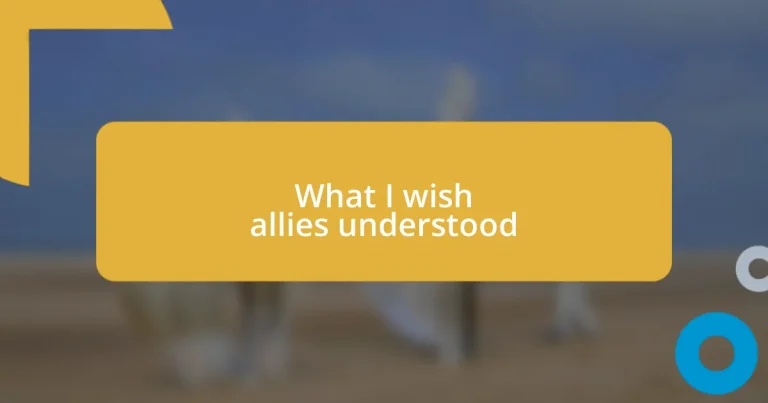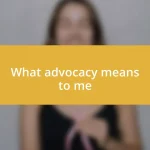Key takeaways:
- Allies should focus on amplifying marginalized voices while ensuring they do not overshadow them, fostering an environment for collaborative dialogue.
- Active listening is essential; it builds trust, encourages openness, and enhances understanding, allowing allies to connect on a deeper level.
- Recognizing intersectionality is crucial in allyship; allies must understand the diverse experiences of those they support to provide tailored assistance.
- Taking meaningful action, rather than just offering verbal support, is key to effective allyship, which involves accountability, education, and collaboration within the community.

Understanding the Role of Allies
Allies play a crucial role in amplifying marginalized voices, which is something I’ve seen firsthand. I remember attending a community meeting where an ally boldly shared their platform to elevate others, creating space for those who often go unheard. Isn’t it remarkable how a single gesture of support can spark a wave of empowerment?
Understanding the emotional weight that allies carry is just as critical. When I first began advocating alongside others in marginalized communities, I was surprised to learn how my willingness to listen and learn became a source of comfort for some. I realized then that being an ally isn’t just about speaking up; it’s also about holding space—creating an environment where others feel safe to express their truths.
It’s essential for allies to recognize that their role is not about taking center stage but enriching the narrative. Has anyone ever overshadowed your voice in a conversation? I have, and it made me acutely aware of how easy it is to unintentionally divert attention away from those who need it most. A good ally knows when to step back and let others shine, fostering a collaborative atmosphere where everyone can thrive together.

Importance of Listening Actively
When I think about the importance of listening actively, I can’t help but recall those moments when I felt truly heard. There’s something incredibly powerful about someone sitting quietly, fully engaged, leaning in with genuine interest. I remember a time when a friend, who was also an ally, encouraged me to share my story without rushing me or cutting in. It felt liberating to express myself in that space, knowing that my feelings and experiences mattered. That active listening created a bond that deepened our relationship and enriched our advocacy work.
Being present is key. Here are some ways active listening can make a significant difference:
- Builds Trust: When I take the time to listen, it shows that I value the other person’s perspective.
- Encourages Openness: I’ve seen how simple nods or words of affirmation invite others to share more deeply.
- Clarifies Understanding: Asking clarifying questions not only demonstrates my engagement but also helps me gain a better understanding of their standpoint.
- Enhances Collaboration: In group settings, active listening allows for richer discussions where everyone contributes meaningfully.
- Reduces Miscommunication: It’s remarkable how much clearer conversations become when we prioritize understanding over responding.
These practices have transformed how I interact as an ally, reinforcing that truly listening goes beyond just hearing words; it’s about connecting on a deeper level.

Recognizing Intersectionality in Support
Recognizing intersectionality in support is something that is often overlooked in allyship. I distinctly remember attending a workshop where a speaker emphasized the complexity of people’s identities—things like race, gender, and socio-economic status intertwining to create unique experiences. It struck me how vital it is for allies, like myself, to appreciate these dimensions. Understanding that not everyone experiences oppression in the same way can profoundly affect how support is offered.
One time, while volunteering at an organization, I met a young woman from a marginalized group who was experiencing multiple forms of discrimination. I shared my own struggles with bias, but it quickly became clear that we were navigating different landscapes. This experience made me realize that acknowledging intersectionality means not only recognizing these differences but also adapting my approach to provide tailored support. It’s about using my voice to elevate those overlapping narratives that may often go unnoticed.
In another instance, during a discussion on community projects, a fellow ally spoke up about the need for inclusive spaces. That resonated with me deeply. I hadn’t thought that the design of our community programs should also reflect the varied identities of the people they serve. This was a pivotal moment for me. It highlighted that truly supporting others involves advocating for specific needs based on their unique intersectional experiences. When allies embrace this concept, real change can begin to unfold.
| Aspect | Ally Understanding |
|---|---|
| Identity | Recognizes only one aspect of a person’s identity. |
| Intersectionality | Acknowledges the complexity of multiple overlapping identities. |

Building Trust Through Transparency
One of the most profound realizations I’ve had about trust is how transparency lays the groundwork for meaningful relationships. I remember a time when I was working on a project with colleagues who were hesitant to share their thoughts, fearing judgment. As I opened up about my own uncertainties, it not only created a safe space but also encouraged them to voice their concerns. This honesty among us deepened our connection and made collaboration much more fruitful.
Trust is built when we don’t hold back the truth. I’ve learned that sharing not just successes but also struggles builds authenticity. I recall a meeting where I shared a failure I experienced in a previous project. Rather than cringing in vulnerability, I saw nods of understanding, and suddenly, we were all sharing our challenges. It was liberating! Isn’t it ironic how admitting shortcomings can strengthen bonds rather than weaken them? It turns out that being transparent about our experiences fosters a culture of openness and encourages others to do the same.
In my experience, transparency isn’t merely about sharing information; it’s about showing the human side of our efforts. There was a point in my journey where I hesitated to disclose certain aspects of my advocacy work, fearing negative perceptions. But once I did, I noticed a shift—the team became more united. Everyone started to share their hurdles, and we collectively brainstormed around those challenges. It’s fascinating how vulnerability can transform a group dynamic into a supportive network. Building trust through transparency creates an environment where people feel valued and heard, and in such spaces, real collaboration thrives.

Effective Communication Strategies for Allies
Effective communication is truly at the heart of allyship. I’ve found that active listening, where I focus entirely on what another person is expressing without formulating my response in my head, can really shift the dynamic. There was a time when a friend shared their experience of discrimination, and instead of immediately jumping in with my opinions, I made a conscious decision to just listen. The emotional weight they carried was palpable, and it helped me understand the nuances of their situation more deeply.
I also believe that asking open-ended questions has been one of my most effective tools. For instance, while discussing a sensitive topic, I once asked, “What does support look like for you?” The response was eye-opening, revealing how individualized the concept of support can be. It made me realize that what may seem supportive to me might not resonate with someone else’s experience. This awareness emphasizes the need to approach conversations with curiosity rather than assumption.
Another strategy I strive to implement is using “I” statements to express my thoughts and feelings. I remember a moment during a heated discussion where I said, “I feel really passionate about creating inclusive spaces because it affects everyone.” This approach not only communicated my commitment but also opened the floor for others to share their feelings without feeling attacked. When I frame statements around personal feelings, it invites collaboration and meaningful dialogue, making it easier for others to engage in the conversation with openness. Isn’t it fascinating how shifting our language can transform our interactions?

Making Space for Marginalized Voices
Creating genuine space for marginalized voices has always been a priority for me. I vividly recall an experience during a community meeting where I had the opportunity to facilitate a discussion on access to resources. Instead of dominating the conversation as I initially intended, I encouraged participants to share their experiences. Listening to their stories was a profound reminder of how much insight we can gain when we step aside and let those most affected speak for themselves.
In my journey as an ally, I’ve come to understand that it’s not enough just to invite marginalized voices into the conversation; we must actively elevate them. There was a moment when I overheard someone sharing their struggles with systemic barriers, and instead of simply agreeing with them, I asked, “How can we support you in amplifying your message?” Their eyes lit up with appreciation, and suddenly, the room shifted. The energy changed, and it became clear that providing platforms for these voices can foster empowerment and growth, not just for them but for everyone involved.
I find it crucial that we also take the time to reflect on our own privileges when making space for others. One day, after an insightful panel discussion, I felt compelled to connect with a speaker who had shared their perspective on racial identity. As we spoke, I acknowledged my privilege and asked, “What challenges do you wish more people understood?” Their candid response truly opened my eyes to the layers of struggle and resilience that often go unnoticed. Such conversations foster mutual respect and understanding, and they remind us of the importance of sharing the mic so that every voice can be heard and valued. Isn’t it enriching when we see the world through someone else’s lens?

Taking Action Beyond Words
Taking meaningful action as an ally requires more than just verbal support; it demands tangible steps that reflect our commitment to change. I remember initiating a community project aimed at providing resources for underrepresented groups. The moment I started coordinating volunteers and gathering supplies, I felt a sense of urgency, knowing that this wasn’t just about ideas but about making a real difference in people’s lives. Isn’t it fascinating how stepping into that role transformed my perspective and deepened my connection with the community?
It’s also vital to approach allyship with a sense of accountability. I found myself in a situation where a close friend spoke candidly about their experiences with injustice, and instead of merely assuring them I stood by their side, I made a pledge to educate myself on the issues that mattered to them. This led me to attend workshops and engage in discussions that expanded my understanding. By actively seeking out knowledge, I realized that my actions spoke louder than any words of support I could offer. How often do we let the opportunity to learn slip by, thinking we know enough already?
Moreover, collaborating with others amplifies our efforts. Recently, I participated in a community forum that brought diverse voices together to discuss local challenges. As we brainstormed solutions, I felt energizing synergy—a collective passion for change that was palpable. It reminded me that when we come together, our combined actions have the power to create ripples that can lead to significant change. Don’t you think it’s in these moments of unity that we truly embody the spirit of allyship?














